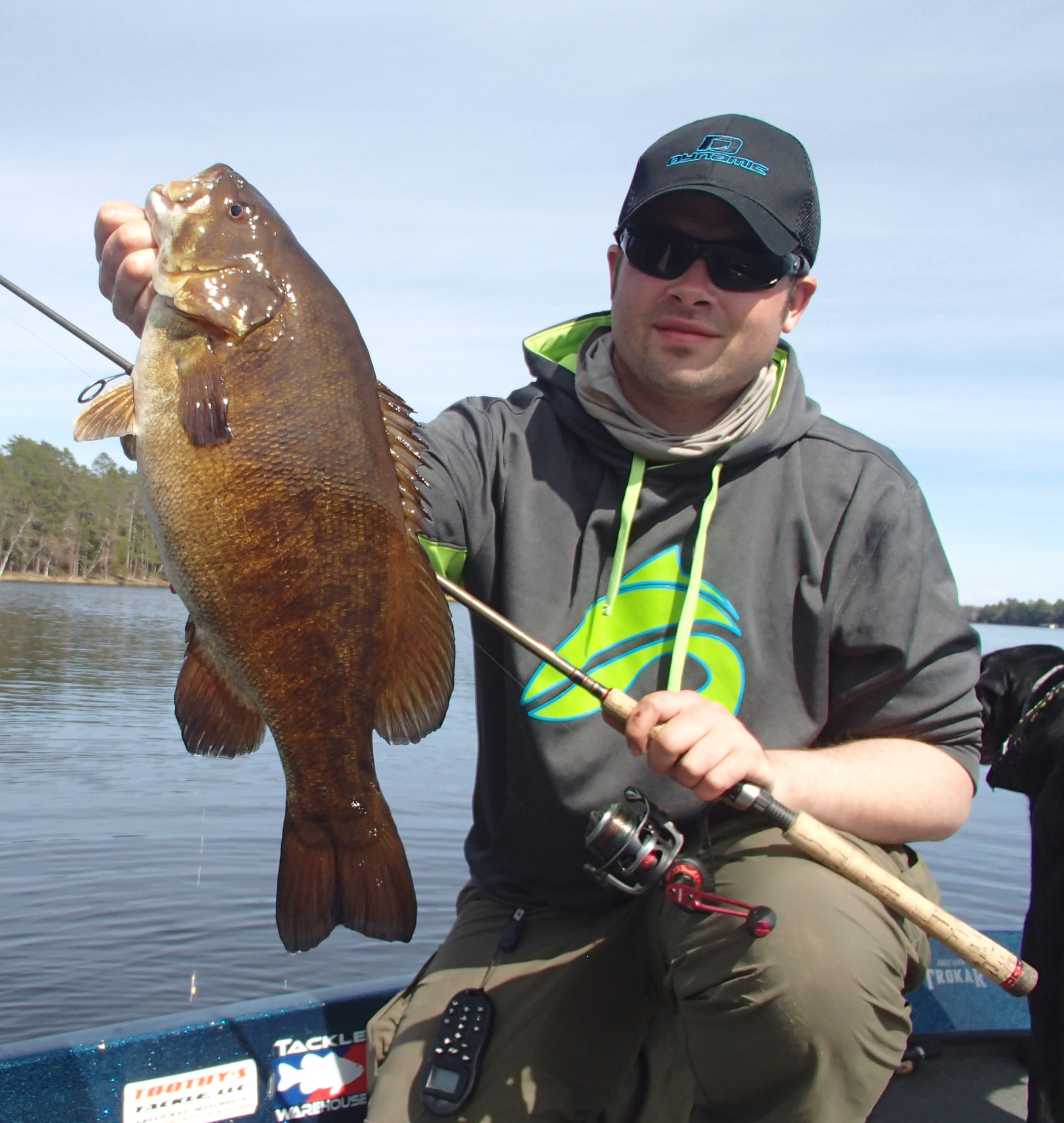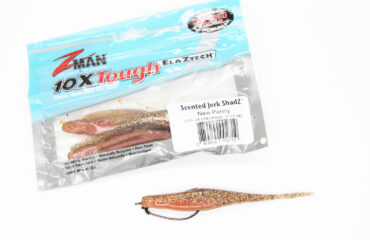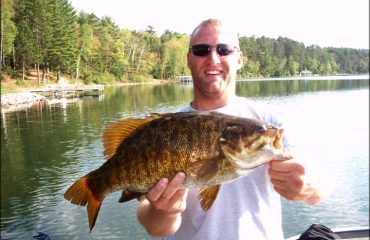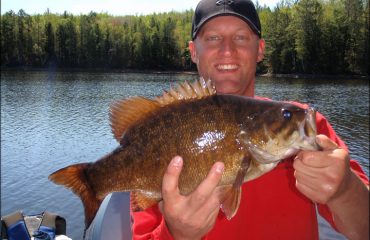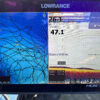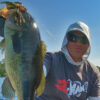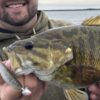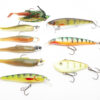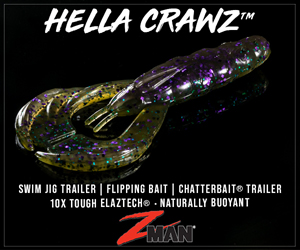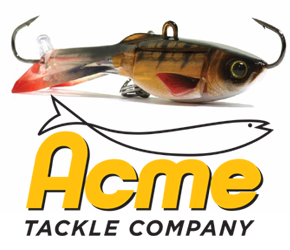Cold War Smallmouth – Winning the Battle
Andrew Ragas
It’s early May, and we’re just a few days removed from Wisconsin’s gamefish season opener. The snow banks and memories winter left behind are yet to melt, ice-out on many northwoods lakes is only starting, and fish haven’t woken up from their winter slumber. The anticipated future forecast for the month is cold, and water temperatures are unlikely to reach the mid 50’s by Memorial Day weekend.
Given these below-average conditions that will now delay spring spawning movements for several weeks, this has suddenly become a peculiar transitional time for smallmouth as well as other species. Thanks to winter’s unwillingness to relent, smallmouth are confused about when to wake up, when to move, and when to feed.
Bites and catch rates during a cold and below-average spring are unquestionably fewer and slower due to a multitude of reactions.
Causes and Effects of Cold Spring
Cold water and below average temperatures are a byproduct of the cold and record-setting winter that commenced first. Winter 2019 was the epitome of brutality. Cold sub-zero days, heavy snowfall of up to 100 inches, ice buildup of up to 3 ft. resulting in winter kills and freeze-outs, and a late ice-out are indicators that we could be in for an unusual spring season.
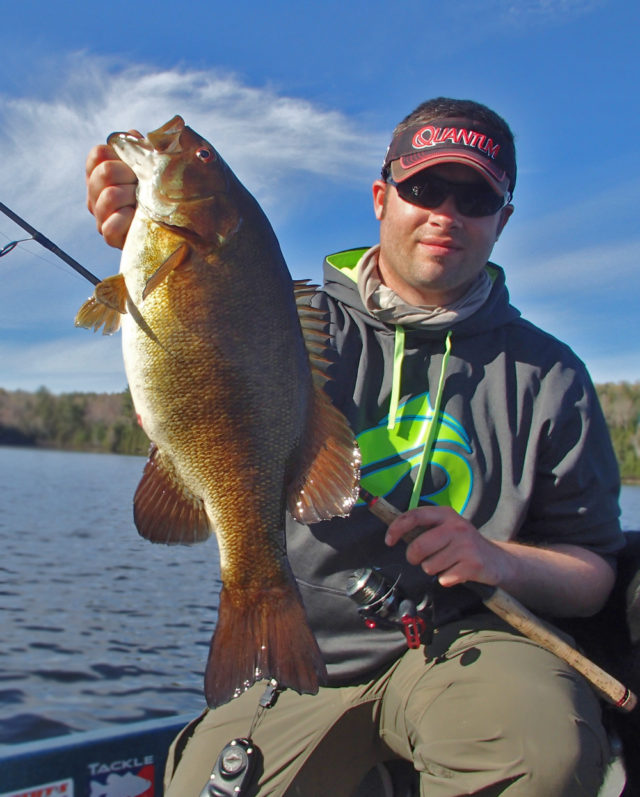
Cold spring climate and water temperature makes smallmouth more inactive. As a result, we must slow down our fishing too. When the aquatic ecosystem is dormant, so too will be smallmouth. Their behavior, feeding, and activity levels are always a product of their environment and weather conditions.
For the entire next month, the fishing will pose several challenges. Water temperatures will barely reach 50 degrees, resulting in much of the lake’s biomass and aquatic ecosystem to stall in stagnation and dormancy. There are several possible reactions to a delayed spring: 40 degree water temperatures all month long; No sunlight; Clouds and rain each day of the week; No weed growth; Few signs of baitfish activity; Shallows and nearly all shorelines are empty except for known staging locations which might be the only areas concentrating bass; A delayed spawn as well as late arrival of summer and fall; Inactive fish, or fish that may be glued and laying along bottom.
These winter after-shocks don’t occur every year, but are characteristics to be expected following the coldest winters we had recently experienced. Warm climates of years past have gradually evolved to colder in recent years, encompassing much sooner snowfall and ice buildup in early November, deep winter freezes, and late ice-outs in early May. Weather is uncontrollable and unpredictable, but could this be a trend we should come to expect and revolve our fishing on?
Beyond environmental and biological effects, cold weather and water temperature affects anglers mentally. Many anglers lack cold water confidence, and it kills their psyche. These last few guiding seasons, water temperatures have mostly dictated when my customers should book their early season trips. Few want to fish when water temperature is mid-40 degrees. Cold water has been responsible for having to frequently re-schedule May dates, or leads anglers to cancel their trips altogether. Most anglers can’t afford fishing in poor conditions. Can you blame them for delaying their trips in favor of waiting for peak periods, warming water, and favorable conditions?
Cold spring climate and water temperature makes smallmouth more inactive. As a result, we must slow down our fishing too. When the aquatic ecosystem is dormant, so too will be smallmouth. Their behavior, feeding, and activity levels are always a product of their environment and weather conditions.
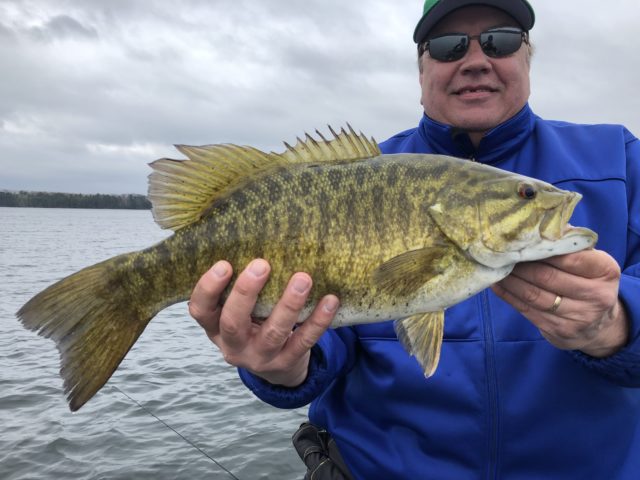
Guide customer, Dave Czeszewski, with his personal best smallmouth. On this day, May 22, 2019, water temperatures were 48 degrees.
Location Precedes Strategy
After ice-out, smallmouth undertake structural migrations from wintering sites to their staging locations, utilizing the lake’s contours and breaklines as their trail in order to reach these temporary destinations. Where they stage and hold until water temperature becomes ideal for invading the shallows will often be situated within a close range from their spawning sites. The same staging locations are re-used by smallmouth annually, and we must revisit them every spring too.
Early in May, and greater emphasized when water temperature is holding in the mid 40’s, seek deeper water first, targeting breaklines at the 10 to 20 ft. level. Look for mid depth structure and underwater holding areas that could be boulders, cribs, wood, and sand bottom. Then as water begins encroaching 50, proceed to staging sites which can be in shallower depths of 5 to 10 ft.
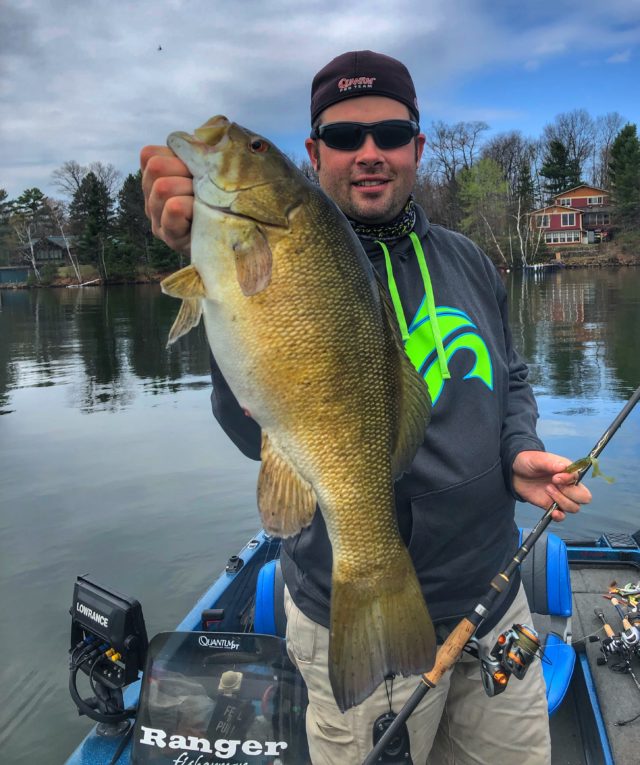
Good smallmouth lakes have many staging locations where fish will gather and hold at until water temperature and timing is right for them to proceed shallow. Smallmouth will visit these locations annually just like they traditionally do for their spawning and wintering sites. Establish a milk run of staging sites on every lake, and you will be revisiting those lakes and locations every spring.
On a lake map, identify entrances of shallow bays, shoreline points, sand bars, shoals, flats, and any isolated obvious shallow structure that has been created by the shape and terrain of the lake. Smallmouth will favor rock, boulder and wood habitat, with a bottom of sand and gravel or rock in any combination at these locations. Then pursue these locations if side imaging confirms presence of fish, the necessary habitat and structure, as well as perfect bottom type. Exposure to sunlight is paramount to the productivity of these areas. If the lake isn’t warming, these spots will be due to sunlight beating down on them. Also important, rock shoals, sand bottom, and wood are the best heat conductors. Their presence on top of a shallow structure will make a high percentage location even better.
When staging sites are located and the pattern gets replicated throughout the entire lake, and others you might visit later that day, 20 to 40 fish days can be accomplished. On the other hand, many northwoods lakes contain few numbers so best yet you can catch a handful of giants. Who could complain!
If smallmouth aren’t staging in cold water, they could also be holding up tight in the extreme shallows. Sand pockets, isolated beaches, and shorelines with exposure to southern skies conduct heat. Smallmouth using these locations will proceed to lie on bottom, absorbing every ray. Additionally, laydowns and shoreline wood will attract fish as well. It’s remarkable to observe how smallmouth congregate and pin themselves to shoreline wood that may in a foot of water. Most smallmouth basking on these underwater microwaves are spooky and neutrally behaved, or can be negative uncatchable. But you’d be surprised by the number of desirable 3 to 4 pounders that can hold and lay in inches deep water just to absorb heat when nothing else is warming.
During late fall and winter, 90% of smallmouth are in 10% of the lake. Early spring fishing adheres to this principle too. Majority of the smallmouth you will catch in spring are located at, or near, staging sites. At this time, fish are still moving and schooling together in heavy concentrations until they disperse and settle on spawning sites.
Most smallmouth anglers are bank beating and covering water in spring. While it’s a very successful strategy during the spawn season when a high percentage of the lake’s bass population invades the shallows, it’s the worst strategy for pursuing staging fish and time management purposes.
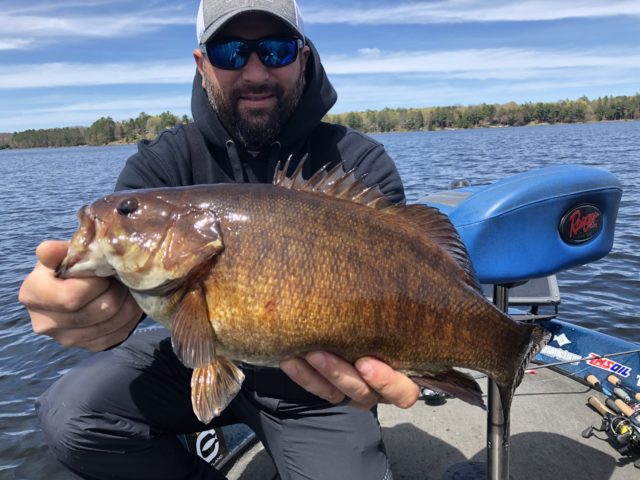
Expect giant pre-spawn smallmouth in early spring. Despite the cold water, they still have to feed and move in to the shallows. Customer Jeff Butler holds a 5.5 pound, 21 inch fish.
In May, my clients and I aren’t the only boat smallmouth fishing. We have company and competition on most lakes every day. While we target only these high-percentage locations and only a small fraction of the lake, most other boats don’t know of these staging sites and high percentage locations, and are combing every mile of shore length. Proceeding to miss feeding windows, anglers then conclude in disgust their day was poor. When smallmouth are staging and concentrating on only a small scattering of precise locations throughout an entire lake, a high percentage of the lake is desolate and empty.
Location always precedes strategy in my boat, and this cold water scenario is no exception. On all smallmouth lakes I fish, we solely visit my milk run of structure routes and staging sites, and camp on them.
This slow method of boat control and spot locking on specific areas enables us to fish meticulously and efficiently, covering all possible casting angles and approaches. We will stay atop these locations 15 to 30 minutes at a time, then revisit again throughout the afternoon in hopes for more rapid feeding windows. Feedback with suspending jerkbaits and slow rolling swimming plastics is usually had within the first 5 minutes targeting these structures. When not feeding, smallmouth will be inactive but catchable, lying on bottom. We must also fish slowly because May feeding windows are rapid but short lived, occurring multiple times throughout the day. Prioritize midday and afternoon hours. The best fishing is expected to happen during periods of sunlight, and when water temperature peaks for the day.
I’ve established the fact that good smallmouth lakes have many staging locations where fish will gather and hold at until water temperature and timing is right for them to proceed shallow. Also, smallmouth will visit these locations annually just like they traditionally do for their spawning and wintering sites. Establish a milk run of staging sites on every lake, and you will be revisiting those lakes and locations every May just as my boat does.
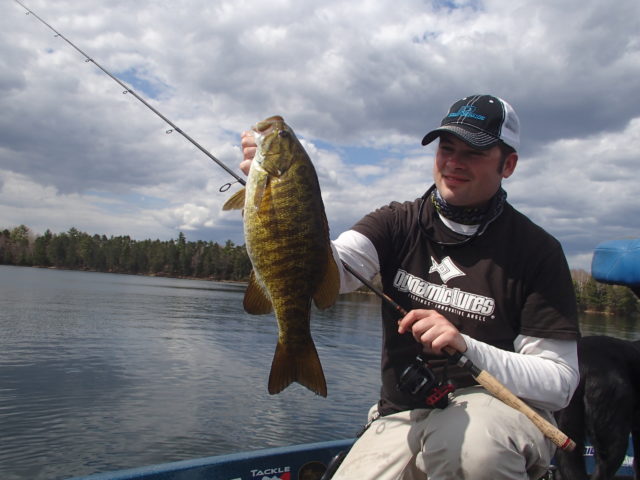
When skies during cold and cloudy days open up, just enough midday sunlight that lasts for a few minutes at a time can open up brief feeding windows.
Baits are Least Importance to This Subject
Slow and subtle rules the day to counter the cold, but bigger is better when targeting the most desirable specimens. Large and lethargic female smallmouth don’t want to waste their limited energy chasing small offerings in cold water. Rather, they favor larger profiles and sizes instead, exerting very little energy to track them down and strike. Slow retrieve speed, and hang time within the strike zone are keys to the game.
Slowly swimming a 5” Kalin’s Lunker Grub on a Trokar Boxing Glove Jig, Northland Slurp! Jig, or other minnow style head conquers the cold water and is most effective when fish are traveling along their deeper structure routes.
Lunker Grubs fished on exposed ¼ oz. minnow heads are my boat’s fish finders and fish catchers on most smallmouth waters. In most water clarities, smallmouth favor naturals and translucents such as Applejuice, Avocado, and Smoke.
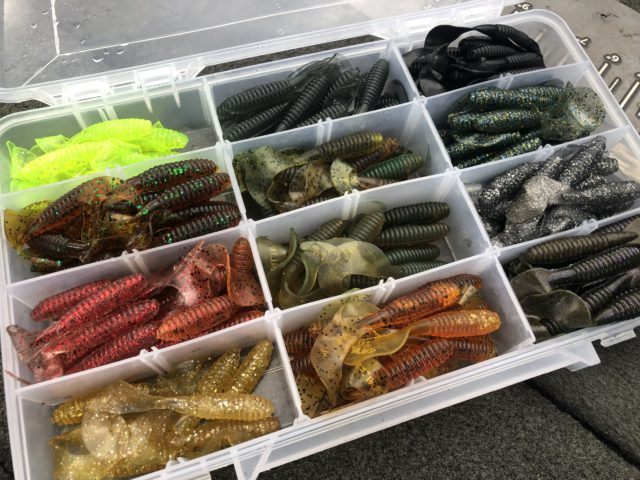
In cold water springs, my box of 5” Kalin’s Lunker Grubs becomes the most important box in the boat. Slow rolling and gently swimming a heavy swimming grub in cold water produces when not much else will.
When fishing the cold water like we did every day in May 2019, slow rolling and gently swimming a heavy swimming grub produces when not much else will. You can often get a nice flurry of bites along the first breaks in 10-15ft depth and atop shallow staging flats when drifting and covering water. The same can also be accomplished with paddletails that includes the Keitech Swing Impact, Kalin’s Sizmic Shad, and Strike King Rage Swimmer each in 3.8” sizes rigged on 3/8 oz. Boxing Glove Jigs with exposed hooks.
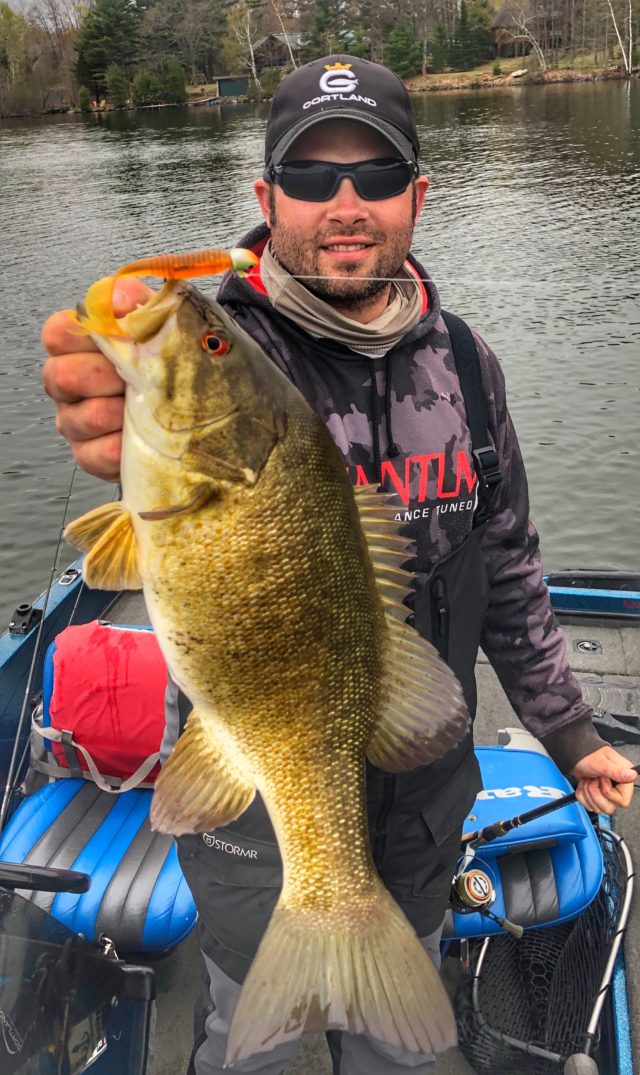
Slow swimming a 5” Kalin’s Lunker Grub on a Trokar Boxing Glove Jig, other minnow style head conquers the cold water and is most effective when fish are traveling along their deeper structure routes.
Bomb cast along the breaks, and run your swimmer thru the lower water column. Turning your reel 1x every second will maintain it at these depths where fish are gingerly migrating up from the deep along these contours.
If not subtle, smallmouth could prefer aggressive strategies on some waters. Lipless crankbaits cast and rip jigged along bottom will surely wake them up from lethargy of winter.
In conjunction with swimming grubs, you will want to have a few suspending jerkbaits tied onto your preferred lines. Never fish spring smallmouth without Rapala X-Rap slash baits in sizes 08 and 10. The size 08 and 10 Hot Head X-rap has been a go-to in May for customers and I these last few years. They excel in cold water, can be manipulated in any manner, and hang motionless in the strike zone for several seconds between jerks. Smallmouth always strike on the pause!
Size 08 is fished best on spinning gear, and worked on 8 lb low-stretch copolymer and fluorocarbon line. My set-up for this is a 7 ft. medium heavy fast action spinning rod with size 30 Quantum Smoke Speed Freak spinning reel. It’s applicable in low wind conditions, when fish favor a smaller forage preference, and when camped atop staging sites. It will eventually make contact with several smallmouth holding near a staging site. The smaller profile of size 08 will not condition smallmouth as quickly as size 10 could.
Size 10 meanwhile is often a big fish target, and gets fished with 6 ft 10” medium heavy extra-fast action baitcasting rods with 6.3;1 gear ratio Quantum PT reels and 10 lb. fluoro line. Last May we had many cold, cloudy, and windy days in which the slower retrieve and bulkier profile of size 10 Hot Head was preferred, and the only color and style of suspending jerkbait smallmouth would slash at.
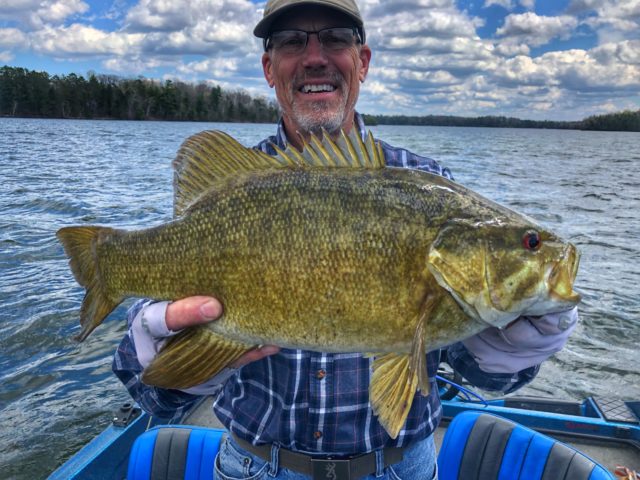
Guide customer, Barry Humiston, put on a clinic with the X-Rap 10 hot head. He fished the bait all day and proceeded to enjoy a 30+ fish trip.
The Hot Head is perfect for cold water smallmouth. It contrasts best on my tannic brown waters, and can be seen by fish from miles away on the clearest waters. It’s the only bait and color type one ever needs.
Finding and catching staging smallmouth with Hot Heads isn’t only a visual presentation, but it’s also a visual experience for anglers. The baits stand out, and because the majority of our bites occur in shallower depths on slack line while the hard bait is suspending between long 5 to 10 second pauses, always keep your eyes fixated on the top six inches of the rod throughout the entire retrieve and observe when the line tightens.
The allure of patterning and catching spring smallmouth during pre-spawn is the propensity of connecting with the largest and heaviest fish of the spring season. These first fish to stage are often big females seeking forage and baitfish to regain their energy stocks before revisiting their annual spawning sites again. Additionally, these specimens haven’t seen other baits for months, and aren’t conditioned to lures like they will be a month from now and later in the year.
Don’t enable the cold war influence spring fishing plans and affect your bass fishing psyche. The challenge and inconvenience of cold spring climate shapes smallmouth bass behaviors and feeding habits more so than the timing of their movements to established location. Regardless of cold water temperature, smallmouth are on the biological clock and must proceed with their spring motions. Remember, smallmouth revisit the same staging locations, spawning sites, and wintering holes annually. Additionally, their activity and behavior is a product of the environment surrounding them. When you can anticipate and know their seasonal locations, and the structural intricacies and hot spots of every lake, catching them and predicting bites during the cold war becomes easy.
Andrew Ragas splits time between the Chicago area and Wisconsin’s Northwoods. Based in Minocqua, WI, he specializes in trophy bass fishing and offers guided trips from May thru October. While big bass is the passion, he dabbles in multi-species as well. He may be visited online at www.northwoodsbass.com


